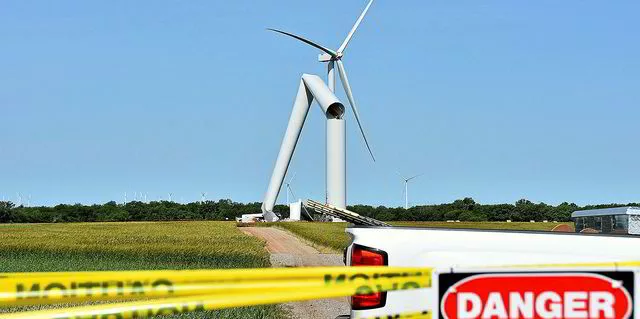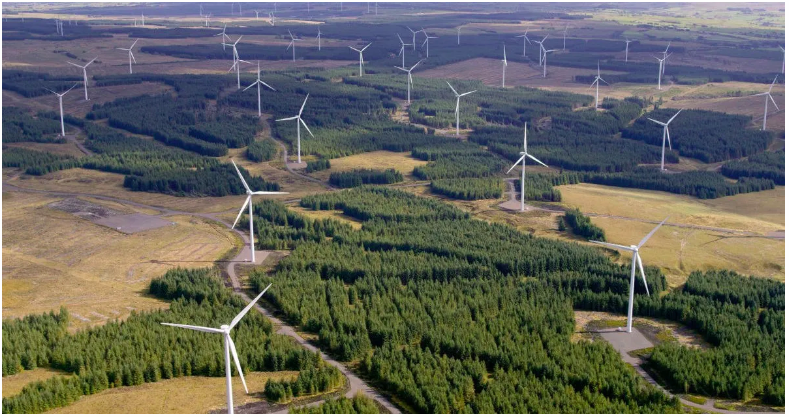With a county commission that wind farm opponents in Douglas County fear is already locked into pro-wind ideology, some opponents of a proposed wind project in southwestern Douglas County are having a tough time celebrating tougher turbine field regulations they say commissioners may still override anyway.
The Douglas County Planning & Zoning board approved those tougher regs by a 6-3 vote last week – the mainstay of which expands the distance required between a wind turbine and a non-participating property from 1,500 to 2,500 feet. Such expanded setbacks are often seen as a “poison pill” in wind farm regulations and are much sought after by opponent groups in lobbying their local leaders. Even in projects that can cover tens of thousands of acres, expanded setbacks can reduce the number of potential construction locations within a turbine field footprint to make it unviable, or force the land plan to shift further from populated areas where more landowners oppose the projects.

That threat was conveyed by NextEra Energy, the proposed project developer, to the Lawrence Journal World by one of its attorneys this week. Alan Claus Anderson told the newspaper those expanded setbacks will scuttle this or any future turbine field in the county.
“If that’s the final regulation, no one will ever do a wind project in Douglas County,” Anderson told the newspaper.
That would be music to the ears of opponents, except for the general belief that the Douglas County Commission has already made its mind up in favor of the project above and beyond the protest of the neighboring landowners. Fifth District Representative to the Kanas House Carrie Barth, (R) Baldwin City, said the vast majority of her mostly rural district opposes the project. She said unelected bureaucrats have exerted pressure on commissioners and planning board members to see the project to fruition.
“The Douglas County Planning Commission was directed by a non-elected bureaucrat, Sarah Pinsky, who stated the Planning Commission needs to write regulations that don’t intentionally or casually ban wind turbines in Douglas County,” Barth told the Informer. “That directive was communicated by one of the Planning Commission members, which no one debated or argued against. This is a direct misrepresentation of what the people of rural Douglas County want and it is unacceptable to put the health, safety and welfare of our citizens at risk.”

Like most wind projects, the Douglas County plan has met substantial resistance from opponents. In February the Franklin County Commission turned down a request for a special use permit that would have allowed the company to build a wind test tower in a portion of the planned construction zone that dips into Northwest Franklin County. Nextera has been looking at Douglas/Franklin County for a potential project since 2013.
The controversy aligns with particular irony in Douglas County, where green energy advocates in Lawrence heavily support wind and solar generating operations, but where rural landowners – and particularly homeowners – fear their home values will be impacted by wind farms when the massive turbine fields make the area less attractive to homebuyers. Others fear possible health effects and the simple negative aesthetics of the huge industrial scens that blot out the rural vista, and others oppose the political machinery that’s heavily subsidized an industry critics say simply can’t produce reliable energy.
Still, enough rural landowners and county commissions have been wooed by wind projects and the lease payments and Payment In Lieu of Taxes to local governments 44 of them have pock-marked the state over the past decade.
Mike Forth, who heads the Douglas County Rural Preservation Association, said the recent NextEra comments are political posturing.
“The new setback requirements do not prevent a commercial wind project – it requires more effort and better planning,” Forth said. He said rural Douglas County’s population has transitioned from larger acreage farming to more rural residences located closer together. The county’s population density, even in the rural areas, makes it not suitable for large scale commercial when generation.

“ Our population density is around 33 people per square mile and a sizable number of those residents live on small acreage land plots of less than 40 acres,” Forth said. “The setbacks are designed to protect landowners, and what NextEra wants fails to provide adequate protection from ice throw, turbine failure, blade failure, fire, noise, etc.”
The final decision on the planning board recommendations will be made by County commissioners, two of whom are up for eledtion in November 2024. the following year, Douglas County will transition to a five-member county commission.
Dane Hicks is a graduate of the University of Missouri School of Journalism and the United States Marine Corps Officer Candidate School at Quantico, VA. He is the author of novels "The Skinning Tree" and "A Whisper For Help." As publisher of the Anderson County Review in Garnett, KS., he is a recipient of the Kansas Press Association's Boyd Community Service Award as well as more than 60 awards for excellence in news, editorial and photography.





